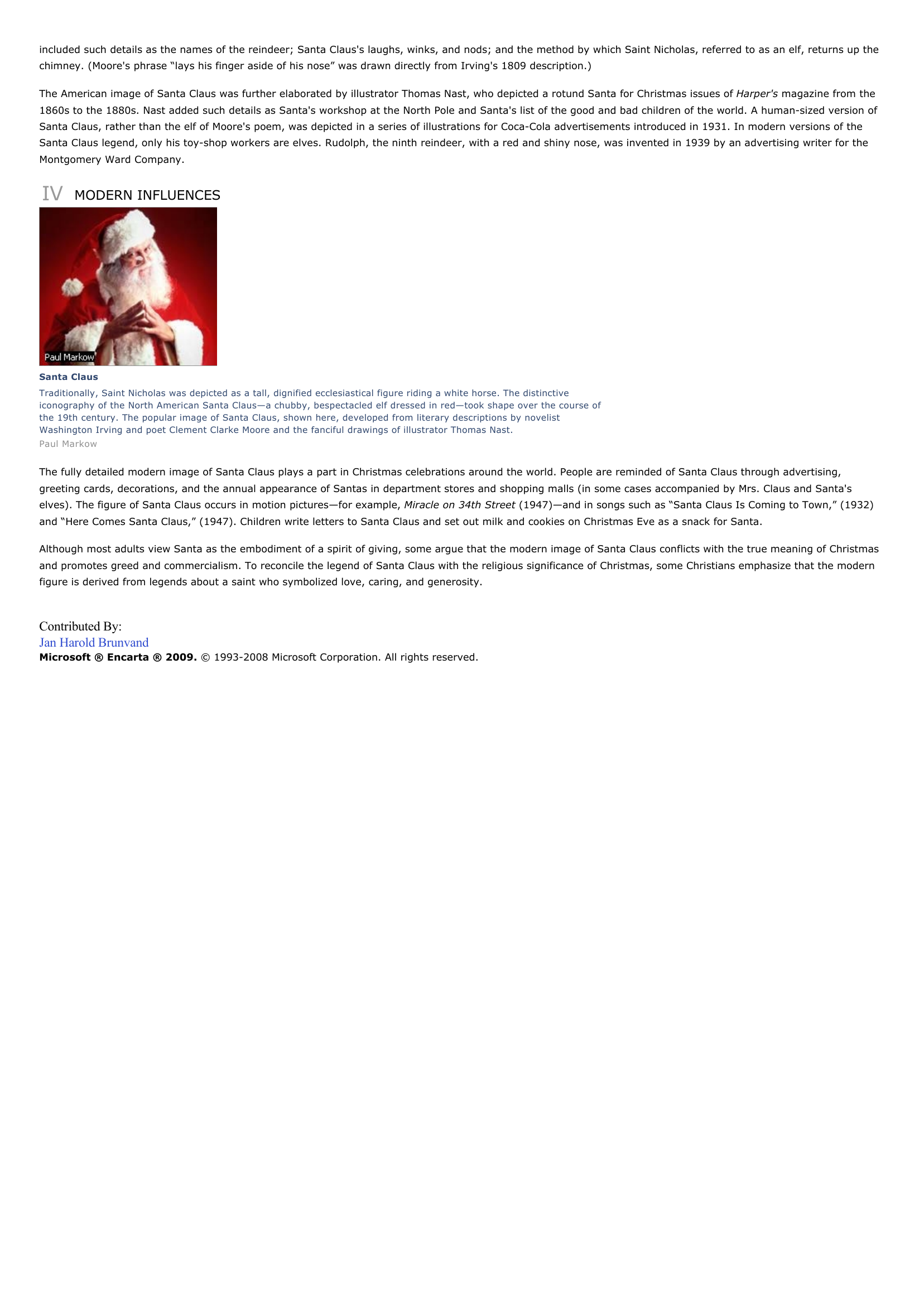Santa Claus I INTRODUCTION Santa Claus, legendary bringer of gifts at Christmas.
Publié le 12/05/2013

Extrait du document
«
included such details as the names of the reindeer; Santa Claus's laughs, winks, and nods; and the method by which Saint Nicholas, referred to as an elf, returns up thechimney.
(Moore's phrase “lays his finger aside of his nose” was drawn directly from Irving's 1809 description.)
The American image of Santa Claus was further elaborated by illustrator Thomas Nast, who depicted a rotund Santa for Christmas issues of Harper's magazine from the 1860s to the 1880s.
Nast added such details as Santa's workshop at the North Pole and Santa's list of the good and bad children of the world.
A human-sized version ofSanta Claus, rather than the elf of Moore's poem, was depicted in a series of illustrations for Coca-Cola advertisements introduced in 1931.
In modern versions of theSanta Claus legend, only his toy-shop workers are elves.
Rudolph, the ninth reindeer, with a red and shiny nose, was invented in 1939 by an advertising writer for theMontgomery Ward Company.
IV MODERN INFLUENCES
Santa ClausTraditionally, Saint Nicholas was depicted as a tall, dignified ecclesiastical figure riding a white horse.
The distinctiveiconography of the North American Santa Claus—a chubby, bespectacled elf dressed in red—took shape over the course ofthe 19th century.
The popular image of Santa Claus, shown here, developed from literary descriptions by novelistWashington Irving and poet Clement Clarke Moore and the fanciful drawings of illustrator Thomas Nast.Paul Markow
The fully detailed modern image of Santa Claus plays a part in Christmas celebrations around the world.
People are reminded of Santa Claus through advertising,greeting cards, decorations, and the annual appearance of Santas in department stores and shopping malls (in some cases accompanied by Mrs.
Claus and Santa'selves).
The figure of Santa Claus occurs in motion pictures—for example, Miracle on 34th Street (1947)—and in songs such as “Santa Claus Is Coming to Town,” (1932) and “Here Comes Santa Claus,” (1947).
Children write letters to Santa Claus and set out milk and cookies on Christmas Eve as a snack for Santa.
Although most adults view Santa as the embodiment of a spirit of giving, some argue that the modern image of Santa Claus conflicts with the true meaning of Christmasand promotes greed and commercialism.
To reconcile the legend of Santa Claus with the religious significance of Christmas, some Christians emphasize that the modernfigure is derived from legends about a saint who symbolized love, caring, and generosity.
Contributed By:Jan Harold BrunvandMicrosoft ® Encarta ® 2009. © 1993-2008 Microsoft Corporation.
All rights reserved..
»
↓↓↓ APERÇU DU DOCUMENT ↓↓↓
Liens utiles
- Robin Hood I INTRODUCTION Robin Hood The legendary hero Robin Hood is a popular figure from English folklore.
- Latin American Architecture I INTRODUCTION Oldest Cathedral in the Western Hemisphere The oldest cathedral in the Western hemisphere is the Cathedral of Santa Maria la Menor, constructed between 1512 and 1541 in Santo Domingo, now the capitol of the Dominican Republic.
- Claude Bernard : Introduction à l'étude de la médecine expérimentale (fiche de lecture)
- Introduction à la Griotique
- Introduction à la recherche documentaire

































